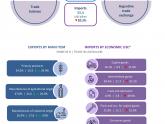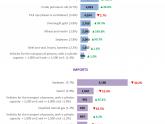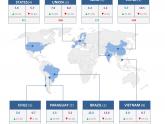Thursday, 19 December 2024
In the January-November 2024 period, exports grew 18.1% year-on-year (reaching USD 72.6 billion), while imports fell 20.2% year-on-year (totalling USD 55.4 billion). Thus, the trade balance reached a surplus of USD 17.2 billion.
HIGHLIGHTS
- Over January-October 2024, exports reached USD 66.2 billion, which represents a 16.9% year-on-year increase, explained by a 24.6% increase in quantities exported that exceeded the 6.2% drop in prices.
- Imports amounted to USD 50.2 billion and fell 21.5% year-on-year, as a result of drops of 3.5% and of 18.7% in prices and quantities imported, respectively. This is mainly due to lower prices of intermediate goods, fuels and lubricants, and a decrease in imported quantities of fuels and lubricants, capital goods and parts and accessories for capital goods. On the other hand, imports of motor vehicles rose, due to an increase in quantities.
- Consequently, the trade balance reached a surplus of USD 16.0 billion, when in the first ten months of 2023 a deficit of USD 7.4 billion had been recorded.

- Prominent are the increases in exports of soybean flour and pellets (USD 2.1 billion), crude petroleum oils (USD 1.5 billion), wheat (USD 1.3 billion, mainly to Brazil and Indonesia) and soybeans (USD 1.0 billion); while the greatest falls occurred in barley grain (‐USD 187 million), lithium carbonates (‐USD 177 million) virgin olive oil (‐USD 165 million) and unwrought silver (‐USD 155 million).
- Regarding the soybean complex, the prices of beans (-20.9%), flour and pellets (-19.2%), biodiesel (-17.7%) and crude oil (‑16.5%) decreased. As for the quantities exported, rises were recorded in those of beans (-160.1%), crude oil (65.3%), flour and pellets (62.0%), and biodiesel (23.8%).
- In relation to imports, the most significant falls occurred in the purchases of soybeans (-US$ 2.1 billion), natural liquefied gas (-US$ 1.1 billion) and gas oil (-USD 1.0 billion), while imports of vehicles for the transport of persons (USD 502 million), and of goods (USD 184 million) grew.

- The main export destinations were Brazil, with a 16.8% share, the EU, 10.3%, China, 8.1% and Chile, 7.9%. In turn, the most prominent sources of imports were: Brazil, 23.1% of total imports, China, 18.5%, the EU, 14.9%, and the United States, 10.6%.
- The largest surpluses were obtained in trade with Chile (USD 4.6 billion), Vietnam (USD 2.2 billion), India (USD 1.9 billion), Peru (USD 1.9 billion) and Saudi Arabia (USD 1.1 billion); while the main deficits were registered with China (-USD 3.9 billion), Paraguay (-USD 1.9 billion) and Germany (‑USD 1.5 billion).

Related documents:





